As an Amazon Associate I earn from qualifying purchases.
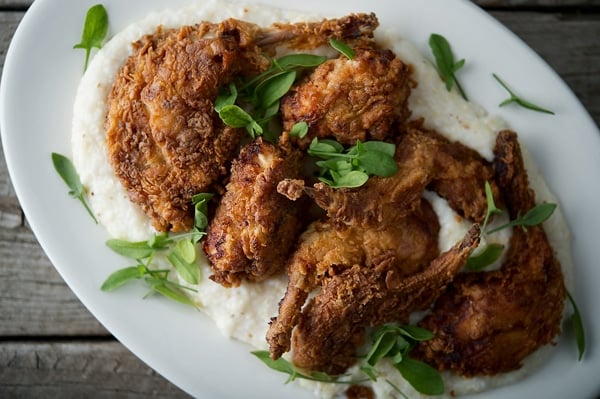
Buttermilk fried rabbit isn’t the fanciest rabbit recipe, but it’s just so comforting. If you like fried chicken — and who doesn’t? — you will like fried rabbit, which is a lot like chicken, in looks, although it definitely tastes of itself, not chicken.
Most people make this recipe with store-bought rabbits, but I use cottontails. If you happen to be blessed with a young snowshoe hare, squirrel or jackrabbit (look for white teeth and ears that tear easily), you use them, too.
My recipe based on a buttermilk fried chicken recipe from my friend Elise at Simply Recipes. I kicked up her spice mix by adding more garlic, cayenne and paprika, thus the red color.
Any spice mix you like works. Cajun, Montreal, Cavender’s, whatever.
You need a lot of oil for this, but you can reuse it. When you’re done, let the oil cool and then pour it through a fine-mesh strainer that has a paper towel set inside it put over a bowl. The paper towel will filter the brown bits and you can just pour the strained oil back into the container. I generally get three uses from my oil.
Most rabbits are sold whole, and if you don’t know how to get them into serving pieces, here is a primer on how to cut up a rabbit.
Serve your fried rabbit with grits, or by themselves with some cole slaw and potato salad on the side. This is picnic food, or food to munch on while watching the game. Like I said, comforting, not challenging.
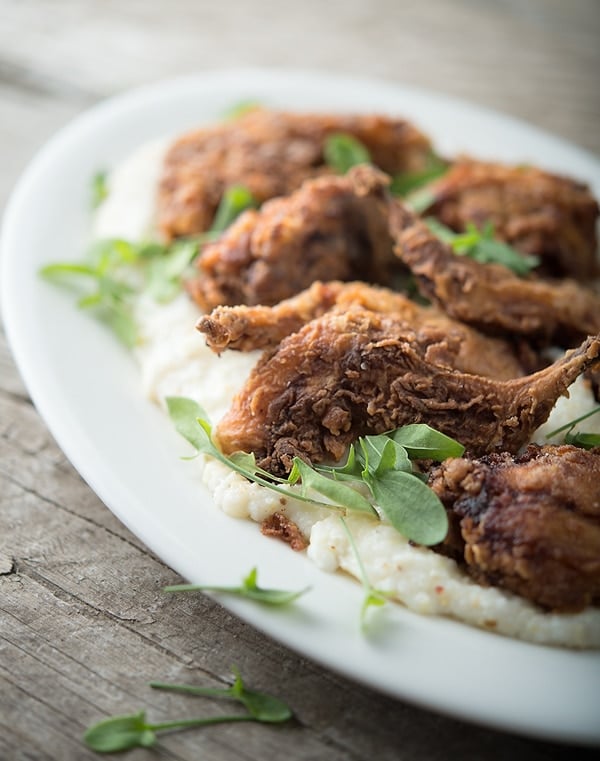
As a general rule, 1 domestic rabbit will serve 2 to 3 people, as will a jackrabbit. A snowshoe hare will serve two, a cottontail and a squirrel just one. You can also do this with chicken (of course), pheasant, quail, and walleye.
Oh, and should you have leftovers, they are fantastic cold for lunch the next day.
Buttermilk Fried Rabbit
Ingredients
- 2 to 4 cottontails, cut into serving pieces
- 2 cups buttermilk
- 2 tablespoons Italian seasoning, or mix together 1 1/2 teaspoons oregano, 1 1/2 teaspoons thyme and 1 tablespoon dried parsley
- 1 tablespoon paprika
- 1 tablespoon garlic powder
- 2 teaspoons cayenne, or to taste
- 1 1/2 cups flour
- 1 teaspoon salt
- 2 cups vegetable oil
Instructions
- Mix the buttermilk with the all the spices except the salt and flour. Coat the rabbit with the mixture and set in a covered container overnight, or at least 4 hours.
- When you are ready to fry, pour the oil into a large pan -- a big cast iron frying pan is ideal -- to a depth of about an inch. The general idea is you want the oil to come halfway up the side of the rabbit. Set the heat to medium-high.
- Meanwhile, take the rabbit out of the buttermilk and let it drain in a colander. Don't shake off the buttermilk or anything, just leave it there.
- Let the oil heat until it is about 325°F; this is the point where a sprinkle of flour will immediately sizzle. When the oil is hot, pour the flour and salt into a plastic bag and shake to combine. Put a few pieces of rabbit into the bag and shake to get it coated in flour.
- Set the coated rabbit pieces in one layer in the hot oil so they don't touch. Fry for about 8 to 12 minutes. Fry gently -- you want a steady sizzle. Turn the rabbit pieces and fry for another 10 minutes or so, until they are golden brown. The forelegs will come out first, followed by the loin, and the hind legs will come out last. You will probably need to fry in batches, so just leave the uncooked rabbit pieces in the colander until you are ready to flour them up and fry them. Don't let floured pieces sit.
- When the rabbit is gready, rest them on a rack set over a paper towel to drain away any excess oil. If you are cooking in batches, set this in a warm oven.
Nutrition
Nutrition information is automatically calculated, so should only be used as an approximation.
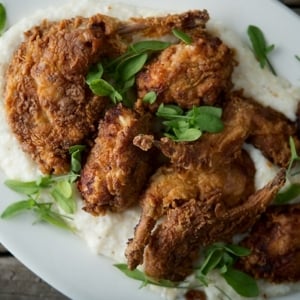
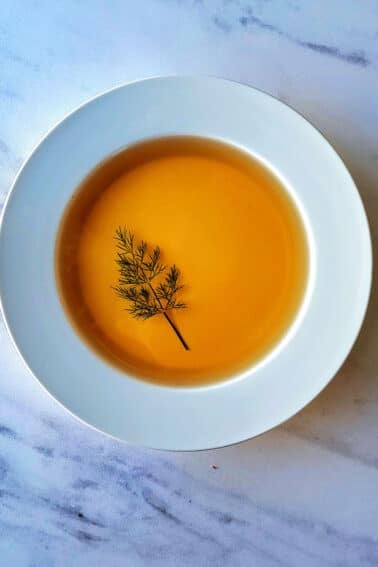
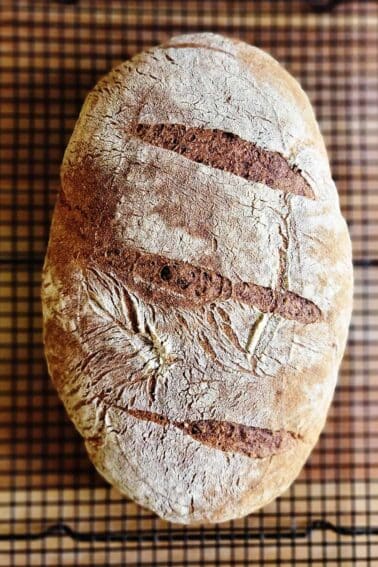

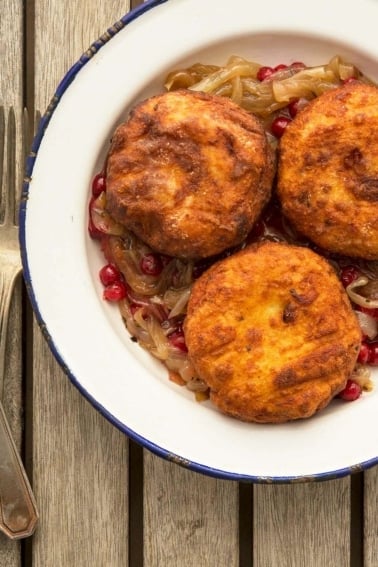
Funny, I always thought Rabbit tasted just like Chicken to me…as well as frog legs…
We trapped our first rabbit this morning, had no plans for supper, so we were eager to have it as a main course tonight. This recipe deserves 5 stars because is really tasty and very easy to do. We followed it exactly, except it was only in the brine for 3 hours and only in the buttermilk marinade for 3 hours, and we didn’t have buttermilk, so we created a substitute with milk and vinegar.
We used our counter top deep fryer, so the rabbit pieces didn’t take much longer than 5 minutes to cook. The flavor of the spices was excellent. The meat was juicy and tender enough for our liking, but if we were to serve this to company, we would plan to allow for longer brine/marinade time as the recipe states to ensure mouth watering tenderness. We commented to each other that it’s so similar in look and flavor to dark meat chicken that we could probably fool people with it. We will definitely be using this recipe again and again.
Thanks!
Kristi
Western Newfoundland
We tried this with a young Mountain Hare today – awesome stuff indeed. And so easy to make too!
Hi
Did this recipe with 3/4 grown rabbit, it was bloody nice.
Cheers Ian…England
Sounds good I’ve never tried rabbit but would like to this recipe is almost like my fried chicken one but without ceyanne in it thanks for the recipe
First attempt at this recipe. Got a 10/10 from the Mrs. I doubled the amounts to do 5 cotton tails. I’ll make some minor changes like add some more slat and Cayenne but other than that…amazing. New favorite bunny recipe.
Usually we fry squirrel shortly after they are skinned. They are usually tough. My husband says its dependant on their age. WoyuWoyuld letting them soak in a brine for 6-8 hours prior to cooking and then following this recipe, or just soakingf them in buttermilk like the rabbit make them fry up tender? They are so tough that you really can’t get most of the meat off the bone! Suggestions?
Brenda: Par cook them until they are tender first, then do the buttermilk fry. The technique is called fricassee — you see it a lot in Southern cooking.
The rooster was fabulous! Had enough room in the marinade bowl for 3 quail! So delicious!
I want to make this today but I don’t have buttermilk. Do you think plain yogurt will work as a substitute?
Also I’m going to try this on my young harvested roosters. They are young and tender. Think 5 hours of marinating will be enough?
I will try this recipe on my rabbits when they are big enough.
Dianna: Yes and yes. Good luck!
Question about the recipe. When you say “coat” the rabbit in the buttermilk mixture, do you mean dip the rabbit into the mixture then place into a container? Or do you mean put the rabbit into a container and then pour all of the mixture over it?
Carl: The latter. I soak the rabbit in the buttermilk mixture for a few hours before frying.
I used this recipe with some older wild cottontails with outstanding results. I was a little scared of the brine having overdone brines before, so I only brined for 4 hours. Soaked them in buttermilk for 8 hours. I’m not sure how it could have been better. Tender and moist with great rabbit flavor. Thanks,
Scott Wood in NC
Hi Hank! I’m considering setting up a rabbitry in my barn if my family and I enjoy the taste of rabbit. I’m honestly looking for a recipe that will get an easy thumbs up from my husband and kids so I can go forth and start building. This first meal might be the only chance I get (I can get adventurous with more exotic recipes later once they’re hooked). Would you recommend the fried rabbit? And if so, any reason I can’t use my deep fryer instead of flipping it in a more shallow pan?
Thanks! Nikki (Austin, TX)
Nikki: This is the one. No one dislikes this recipe. 😉 And sure, you could use a deep fryer.
I made this recipe for the second time today. The first time I used a young cottontail and it was outstanding! But today I used an older rabbit and it was a bit tougher and too salty. I think I followed the recipe exactly as before; the only difference was that I brined the second rabbit for much longer (maybe 9 hours). Do you think that was too long for a wild rabbit? I will definitely try it again but I’ll keep this one for the young bunnies. Thanks for posting such great recipes!
Jon: Yep. If you think the rabbit was salty, the brining process was too long.
I grew up in Atlanta Georgia on a small farm. We raised chickens, rabbits, ducks and turkeys. Your buttermilk recipe sounds like the way mom and dad cooked the domesticated and wild rabbits and chickens that were fried up in large quantity. That was the best I have ever had. I am looking forward to trying your posted recipe. Thanks for the listing.
I’m a southerner transplanted in Montreal. There’s lots of wonderful things to eat here but good fried chicken is hard to come across. I work at a farm and somebody let the boy rabbits get in with the girl rabbits and now there are way more than we need. Lucky me. I made this a couple days ago and have been dreaming about it since then. I’d dare say the best fried chicken I ever had was a rabbit. Thanks!
Hello,
This sounds extremely delicious, but I was wondering how it can be adapted to a full sized rabbit (about 1 kg or 2.2 lbs). The pieces will be bigger, so it may require a longer cooking time. Will the 10 minutes o frying on each side be enough?
I can’t wait to make this =)
Amna: You are right. A full sized rabbit will need a bit longer. Drop the heat a little and fry longer, maybe 12 to 15 minutes per side. If you are worried it’s not cooked all the way to the bone, you can put the pieces in a 225 degree (Fahrenheit) oven for 15 minutes or so.
Hi Hank me and my wife live in French River Ontario Canada, I put some snare about 6 or so and on the next day we got a snowshoe hare, I gut it and got it to sit in the brine and we are gona do the butter milk recipe, it look so good…we will repost the result
Decimated the local rabbit population this summer to save wife’s garden & haven’t yet started on the ABUNDANT squirrel population both in woods & on the bird feeders, but lots of pheasant breast in freezer so used that. Brined for a couple hours first then into buttermilk marinade overnight. This recipe immediately made my top 10 ways to prepare pheasant!!! Thanks a bunch!
I wish I’d had this recipe when I lived in Japatul Valley outside San Diego years ago. Them rabbits came out every night to steal the hay and it would’ve been nice to even things up a bit.
Hey there Hank – recipe looks fantastic. I’ve been a long time reader, ever since your article on “Lake Erie Perch Chowder” was passed along to me from a fellow Clevelander – really appreciate the positive and honest reporting on the area and its fisheries.
Anyway, I haven’t done much in the kitchen with rabbit, but was wondering what preparation you’d suggest if I wanted to combine your Pigeon Tortellini recipe with Rabbit? Specifically, would I pan-brown and roast the rabbit or should I braise? And what type of fat would you use with it? Main concern would be drying out the filling…
Thanks again and keep up the fantastic work! – Ian
If you want to make tortellini filling, you’d want to braise the rabbit until the meat fell off the bone, then chop and shred. Hope that helps!